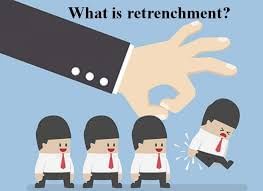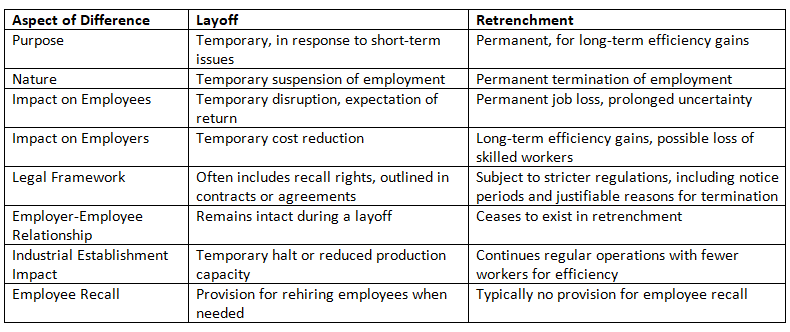Lay-off & Retrenchment | Business Law - B Com PDF Download
| Table of contents |

|
| Introduction |

|
| Definition of Layoff |

|
| Definition of Retrenchment |

|
| Difference Between Layoff and Retrenchment |

|
| Conclusion |

|
Introduction

The Industrial Disputes Act of 1947 is a significant piece of legislation that deals with employment-related matters, including the concept of layoff and retrenchment.
Importantly, regardless of whether an employee is laid off or retrenched, the loss of employment is not attributed to the employee’s actions or fault. These employment actions are initiated by employers due to various operational and economic factors. The Industrial Disputes Act provides a legal framework to ensure that layoffs and retrenchments are carried out fairly and with appropriate procedures to protect the rights and interests of both employers and employees.
Definition of Layoff

A layoff means when an employer doesn’t offer a job to a worker whose name is on the worker list for their industrial business. This happens when the employer can’t provide work due to reasons like not having enough electricity, coal, materials, having too many goods in stock, machines breaking down, natural disasters or other good reasons. This definition is in Section 2(kkk) of the Industrial Disputes Act, 1947.
Requirements for a Layoff
- The employer can’t provide work to the workers.
- This inability to provide work should be due to a lack of electricity, coal, materials, excess stock, machine breakdown, a natural disaster or other valid reasons.
- The worker’s name should be on the employer’s list of workers for their industrial business.
- The worker shouldn’t have been fired.
If a worker’s name is on the employer’s list and they show up for work but aren’t given work within two hours, they are considered laid off for that day. Similarly, if a worker is asked to work during the second part of their shift and gets work, they are seen as laid off for the first part of the day. If they show up for work during the second part of the day and still don’t get work, they are considered laid off for the whole day.
Definition of Retrenchment

Retrenchment, as defined in Section 2(oo) of the Industrial Disputes Act, 1947, means letting go of an employee for reasons other than as a punishment for disciplinary actions. However, it doesn’t include voluntary retirement, retirement at the specified age in the employment contract, termination due to ongoing illness or the natural conclusion of an employment contract.
Requirements for Retrenchment
- The employer must provide the employee with a written notice explaining the reasons for retrenchment or they must pay the employee their salary for the notice period, as per this Section.
- When an employee is let go, the employer must give them compensation equivalent to 15 days’ average wages for each year they’ve continuously worked.
- A notice of the reduction in the workforce must also be given to the relevant government.
Difference Between Layoff and Retrenchment
Layoff and retrenchment are two distinct employment actions with important implications for both employers and employees. While they may appear similar at first glance, they differ in several significant aspects.
1. Purpose
- Layoff: Layoff is typically initiated as a temporary measure in response to short-term challenges faced by the employer, such as seasonal fluctuations, economic downturns or unforeseen circumstances like the COVID-19 pandemic. The primary purpose of a layoff is to reduce labour costs during a temporary period.
- Retrenchment: Retrenchment, on the other hand, is a permanent action taken by the employer to restructure the workforce for long-term efficiency gains. It aims to permanently reduce the number of employees to align with operational needs.
2. Nature
- Layoff: A layoff is a temporary suspension of employment. During a layoff, employees remain connected to the employer and there is an expectation of reemployment when conditions improve.
- Retrenchment: Retrenchment results in a permanent termination of employment. The employment relationship ceases and there is no expectation of rehiring the affected employees.
3. Impact on Employees
- Layoff: Employees experiencing a layoff face temporary disruption in work and income. However, they retain the expectation of returning to their jobs.
- Retrenchment: Employees subjected to retrenchment face permanent job loss, leading to a prolonged period of uncertainty regarding future employment prospects.
4. Impact on Employers
- Layoff: Employers use layoffs as a cost-cutting measure during temporary economic downturns. It allows them to reduce labour costs temporarily while retaining the option to rehire when the situation improves.
- Retrenchment: Retrenchment is typically implemented for long-term efficiency gains. Employers permanently reduce the workforce to align with operational needs and reduce overhead costs. However, they may lose skilled workers.
5. Legal Framework
- Layoff: The legal framework for layoffs often ensures that employees receive recall rights. Layoff terms are typically outlined in employment contracts or collective bargaining agreements.
- Retrenchment: Retrenchment is subject to stricter legal regulations in many countries due to its permanent nature. Legal requirements may include notice periods, severance pay and justifiable reasons for termination.
6. Employer-Employee Relationship
- Layoff: During a layoff, the employer-employee relationship remains intact. Employees expect to return to their jobs when the layoff period ends.
- Retrenchment: In cases of retrenchment, the employment relationship ceases to exist. Employees are not expected to return to the same employer.
7. Industrial Establishment Impact
- Layoff: During a layoff, the industrial establishment may temporarily halt operations or reduce production capacity due to decreased workforce availability.
- Retrenchment: In retrenchment, the industrial establishment continues its regular operations without the terminated workers, aiming for more efficient and cost-effective operations.
8. Employee Recall
- Layoff: Layoffs often include provisions for employee recall. Employers can rehire employees when business conditions improve without the need for a new hiring process.
- Retrenchment: In retrenchment, there is typically no provision for employee recall, as the termination is permanent.
Summary of Key Differences

Conclusion
Layoff and retrenchment are two different employment measures outlined in the Industrial Disputes Act of 1947 in India. A layoff refers to the temporary suspension of employment, usually due to short-term issues such as lack of raw materials or financial difficulties. In contrast, retrenchment is the permanent termination of an employee’s service, often carried out to improve the long-term efficiency of an organization.
Layoffs are governed by specific rules that often include provisions for recalling employees once the situation improves. On the other hand, retrenchment must follow legal requirements such as providing notice periods and having valid reasons for the termination. While both measures help employers manage staffing levels, they serve different purposes and carry different consequences for both employees and employers. Recognizing the distinction between them is important for understanding the fundamental aspects of labour law.
|
30 videos|100 docs|17 tests
|
FAQs on Lay-off & Retrenchment - Business Law - B Com
| 1. What is the main difference between a layoff and retrenchment? |  |
| 2. What are the requirements for a layoff? |  |
| 3. What are the compensation requirements for retrenchment? |  |
| 4. Can employees expect to be recalled after a layoff? |  |
| 5. What legal framework governs layoffs and retrenchments? |  |



















